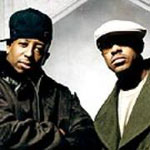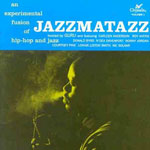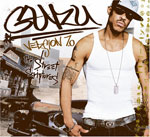
Now there’s a school of thought, led by one Tony Wilson, that says Happy Mondays’ Shaun Ryder is the unique poet of his generation, and this is a school of thought I totally buy into, having studied Mr Ryder’s wordplay in intimate surrounds. He sure as hell knew what he was doing then. The whole group did. They were off on their own, yup, but they were tapped into something special, and no matter how Mr Ryder tries to deny it now his early lyrical flow really was up there with the most inventive poetry, so much so that you begin to wonder just how.
Now while Mr Ryder may be in denial, there’s no doubt in Guru’s mind that he, Mr Keith Elam, the Gifted Unlimited Rhymes Universal, really is a poet of the streets, the voice of the dispossessed, ghetto defender, an educator, protecter, and philosopher, a man looking for the light and the truth, whereas Mr Ryder was content to dig among the dirt and the darkness. Guru just happens to be my favourite MC, and I think the records he made with Gang Starr in the ‘90s are about the best hip hop records ever. So why do I almost feel guilty saying that?
Guilt’s a big part of the pop process. Some have made a big thing about guilty pleasures. Myself, I feel guilty I don’t like, say, Prince or the Pixies as much as I could. I feel just as guilty that I have never got into the whole gangsta rap caboodle of NWA, Snoop, Dre, Tupac, whatever, thus denying myself the right of enjoying that whole multi-million dollar industry as a guilty pleasure. It’s not even a high-handed moral decision. It’s just not done anything for me.

And that something special was the way Guru delivered his rhymes. His precise and portentous tones seemed removed from the crowd trying to move the crowd. His deceptively laid back lyrical flow seemed a perfect excuse to trot out phrases like laconic and lugubrious. Essentially when others were shouting so loud, Guru could come across as the wise one, thoughtful and still as tough as anyone else? Guru was a romantic rebel in the tradition of my own heroes, like genial Joe Strummer, Kevin Rowland and Mark Stewart, maybe playing a part, full of contradictions, but totally immersed in that role. He had absorbed James Brown, the Last Poets, Curtis Mayfield, and had a lot to say.
For many the better half of Gang Starr will always be DJ Premier, an alchemist who turned the whole thing of scratching, sampling, mixing, and assemblage into a higher art form. He did this at a time when you could get away with much more (like the blatant but brilliant use of Marlena Shaw’s rendition of Ashford and Simpson’s 'California Soul' on 'Check The Technique'), when samples didn’t need clearing, when the whole thing of sampling was still vital and controversial. Premier’s fingerprints would be over a lot of the most important sounds for years to come, and his extra curricular activities, including the magical Sun Rises In The East for acolyte Jeru the Damaja still amaze.

But it’s Guru that
does it for me. Take 'Check The Technique', where Guru soars over the
California Soul montage, and then slips into 'Lovesick'. Now I’m shamelessly
happy to admit my own guilty pleasure for many a year was to put Gang
Starr’s
joyous 'Lovesick' on any compilation tape next to Orange Juice’s 'Lovesick',
when such things mattered more than the sun. Nothing could be more certain of
putting a smile on my face or a spring in my step than those two songs back-to-back.
I love Guru talking his way through 'Lovesick'. There’s something wonderful about
the tough guys showing their tender side, like The Fall suddenly coming up with
'That Man' when you least expect it, or Mark Stewart singing a love song as fiercely
as any of his protests.
If it can feel too obvious saying Gang Starr are the best, I guess it maybe somehow
connected with that guilt thing of loving the most militant reggae, the most
committed conscious roots acts, when you’re miles and lifetimes removed from
what’s generated such raw sounds. And, yes, you can put Guru up there with Prince
Far I, Yabby You, Big Youth, Trinity, Tapper Zukie, and so on. That link works,
though it’s really the jazz that Guru connected to.
Right from the start Gang Starr explicitly went further even than Stetsasonic
in referencing the jazz in their music. Guru himself went further still with
his extra curricular activities as Jazzmatazz, where he got together with a stellar
cast of old school jazz figures (like Donald Byrd, Freddie Hubbard, Ramsay Lewis,
Roy Ayers, Bernard Purdie) and important new voices (Shara Nelson, MC Solaar,
Carleen Anderson, Bahamadia, DC Lee) for a wildly ambitious series, which against
all the odds has aged pretty well.
The first two Jazzmatazz sets were put together right at the heart of the Acid
Jazz/Talkin’ Loud/Mo’Wax thing, where hip hop and jazz and reggae and rare funk
grooves were thrown together by people like Gilles Peterson and Eddie Piller,
the latter of whom had evolved through the mod resurgence, the reawakening of
interest in the source sounds, and on into the jazz. The Jazzmatazz counterparts
here were the likes of the Young Disciples, Galliano, A Man Called Adam (who
Piller called the ultimate mod group) and on into RPM and Attica Blues at Mo’Wax,
and yes it was a contagiously creative and productive time whatever anyone else
may try to tell you.

Interestingly The Roots from Philadelphia seemed to take the Gang Starr thing on a bit further, with conscious rhymes, imagination, integrity, old school roots and jazz connections. What was interesting about The Roots and their extended family was their organisational excellence, and in particular the divergence into production duties. The Roots’ fingerprints were all over many of the best sounds from the emerging streetsoul, or whatever you want to call it, where hip hop blended with what I am very wary of calling real soul, but essentially we are talking about a sort of music that connected directly to old soul sounds of the Roberta Flack, Stevie Wonder, and so on, vintage. And the likes of Erykah Badu, Jill Scott, Angie Stone, Jazzyfatnastees, Lina showcased some exceptional vocal performances, while some of the Roots’ acolytes like Scott Storch and James Poyser had their names on many of the credits that counted in years to come. Guru himself tapped into the streetsoul thing with the third instalment of the Jazzmatazz series, making some very natural connections.
There was always a danger of Guru becoming a caricature, skulking in a corner, declaiming how he could have been a contender but he never sold out, and spent his time keeping it real, whatever that means, and for that reason you could understand even old fans steering clear of the 2005 Street Scriptures set, like even the oldest Fall fan might avoid another Mark E Smith record. But that would be a big mistake. The Street Scriptures actually has some magical moments, like 'Cave In' which cheekily reprises the downtown sound of the Liquid Liquid 'Cavern' motif, linking it right back to Grandmaster Flash’s 'White Lines' all those years before.
Yet before you write off Guru sitting there with his old Sugarhill records like Mark E Smith with his Link Wray discs, saying this is how it ought to be, it should be mentioned Street Scriptures features contributions from two of the most important voices around, both ironically with Roots connections but heyho, in Jean Grae and Jaguar Wright. Indeed Jaguar joins Guru on the excellent 'Feed The Hungry', where the fine sentiments may have you running for the hills, but sometimes the obvious needs reaffirming. And we need our street corner intellectuals like Guru to remind us of what we tend to forget
© 2006 John Carney